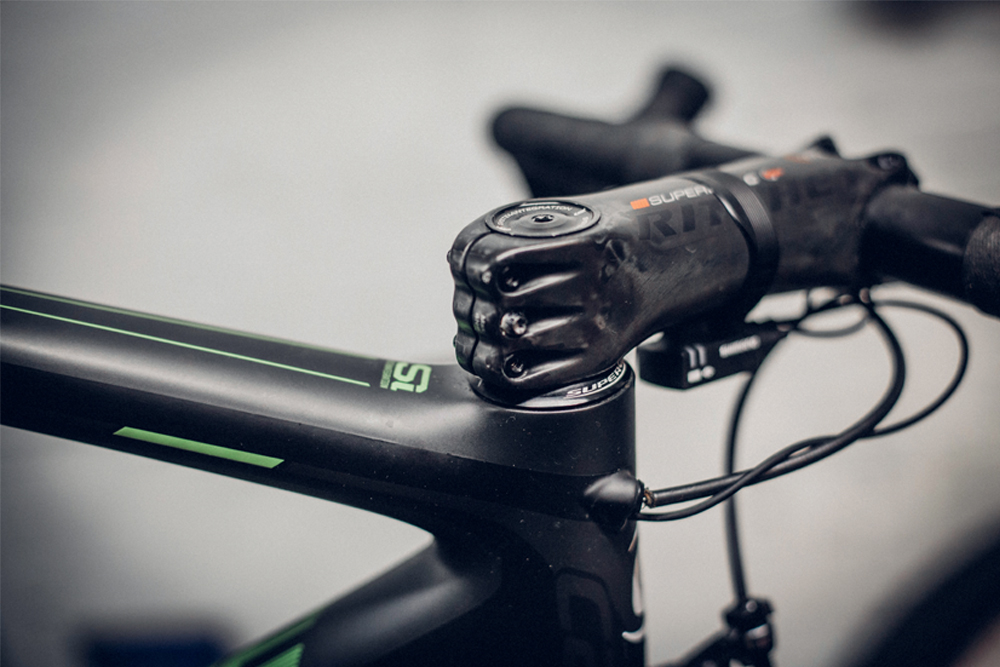Should you slam your stem: yes or no?
Running a very low stem may be a growing trend among pros, but would it make you faster — or merely put you at heightened risk of injury?

Take a look at most of the bikes in the pro peloton and you’ll notice that most riders run their stem very low, often snug up against the headset. Slamming your stem, as this is known, is en vogue, but does it yield performance benefits for normal riders like you and me, or does it expose us to injury risk in pursuit of fashion?
>>> Handlebar reach: how to get it right (video)
The most obvious performance benefit from slamming your stem, and the reason that many pro riders such as Lotto-Soudal’s Adam Hansen do it, is that a lower front end is more aerodynamic.
According to Dr Xavier Disley, founder of AeroCoach, “A reduction in stack height by something like 20mm could easily save six to 10 watts in aerodynamic drag at around 20mph, if the cyclist reduced their torso angle accordingly.”
>>> Why amateurs shouldn’t try to pedal like Chris Froome
However, this aerodynamic benefit only manifests itself if the rider is strong enough to maintain a low position. Indeed, Specialized aerodynamic R&D engineer Chris Yu thinks that the idea that lower equals faster is a big misconception. “In working with many of our pro athletes, we’ve found that it’s nearly 50/50 whether lower is better or worse aerodynamically,” he said.
“Many times, lowering the stem can have unintended consequences such as causing additional shoulder strain that leads to a minutely higher head position, the net effect of which is a higher aero drag signature.”
The latest race content, interviews, features, reviews and expert buying guides, direct to your inbox!
How to set your handlebar height
Positioned for power
Just as important, according to Yu, is finding a position that doesn’t compromise power output. “Each athlete has a sweet spot that optimises the combination of aero drag and power output to achieve the fastest overall position. And for many athletes — myself included — that position is not necessarily slammed.”
Disley agrees: “Any reduction in stack height needs to be evaluated against the individual’s morphology and anthropometrics.
“If you have terrible flexibility, then you might be better served maintaining a lower position on the bars just by bending you arms a touch more rather than putting the stem lower.”
>>> Five exercises to prevent and treat cycling neck pain (video)
Indeed, talk to most bike-fitters and they will tell you that flexibility is the most important factor when it comes to deciding whether to slam your stem. “The limiting factors are lower back and hip flex upper limits,” says James Wakelin, senior bike-fitter at Condor Cycles, who stresses the importance of weight distribution with different styles of bikes and riding.
“Weight distribution will vary depending on the style of the bike. For example, a road/criterium race position will put much more weight on to your arms than a sportive rider set-up.
“In essence, the basic rule is that you should be able to turn the pedals smoothly in the drops without affecting your hip rotation and putting too much stress on to the arms.”
Get aero on your road bike
Potential pitfalls
So what are the potential pitfalls of slamming your stem without having the necessary flexibility? Unfortunately, injury seems to be a common outcome; Wakelin tells of numerous problems caused by riders slamming their stem. “I’ve seen customers experience massive pain in their hips and lower back from trying to run too little stack.
“I have also had a few customers who have ended up with big problems in the groin from applying too much pressure caused by a low front end.”
>>> Are electronic groupsets necessary?
If you’re considering slamming your stem, the best advice is to consult a bike-fitter, who will tell you whether it’s a feasible change for you. And if the answer is no, it’s best to pay attention — unlike the customer who came to Wakelin for a bike-fit and then took it upon himself to fit a -17º stem at a later date. “He did have a few problems as a result of that…”
Our take
If you’re flexible enough, there’s no reason not to slam your stem. If you can hold the position and keep your head and shoulders low, there are certainly aerodynamic benefits, especially when combined with narrower bars.
However, with cyclists not exactly renowned for their flexibility and upper body strength, slamming your stem could make you a less efficient rider and even put you at risk of injury, so it’s best to have a bike-fit before you go cutting that steerer tube.
What do the experts think?
Yes: Adam Hansen, Lotto-Soudal pro rider

“I do it for aero reasons. If you can gain a 10-15-watt advantage from your normal riding position, then do it. It’s very difficult to improve your power by 10-15 watts, so if slamming your stem gives you free watts, then slam it and get used to it. Plus, it just looks the part.”
No: James Wakelin, senior bike-fitter at Condor Cycles
“Only flexible riders should slam their stem, as the limiting factors are lower back and hip flex upper limits. I think most studies have shown that the aero effect is mainly down to a smooth style and narrow body posture.”
Henry Robertshaw began his time at Cycling Weekly working with the tech team, writing reviews, buying guides and appearing in videos advising on how to dress for the seasons. He later moved over to the news team, where his work focused on the professional peloton as well as legislation and provision for cycling. He's since moved his career in a new direction, with a role at the Department for Environment, Food and Rural Affairs.